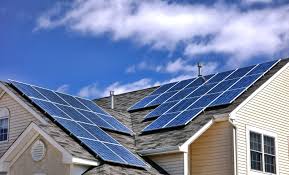1. Introduction
Make a brighter future with eco-friendly roofing!
Are you concerned about the sustainability of the planet and natural resources? Are you looking for energy generation alternatives? Florida’s sunny climate makes it an ideal location for solar power generation. The state receives abundant sunlight throughout the year, which can be efficiently captured by solar panels installed on rooftops.
The benefits of solar roofs include reducing dependence on traditional energy sources, saving on electricity bills, and contributing to a cleaner, more sustainable energy future.
Today, we tell you everything you need to know about the transition to clean energy sources, from the advantages, challenges, installation process, and trends.
Let’s get started!
2. Importance of Solar Energy in Florida
Florida Climate and Solar Power has excellent potential as the state is characterized by long, hot summers and mild winters. The region experiences an average of 230 to 260 sunny days annually, providing ample opportunities to capture solar radiation for power generation. Florida solar contractor, such as photovoltaic (PV) panels, can be installed on rooftops, solar farms, or carports, providing a clean, renewable energy source.
Adopting solar energy in Florida can help reduce the demand for fossil fuels, reduce greenhouse gas emissions, and mitigate climate change. It represents a significant opportunity for change because, according to the EIA, Florida ranks as the 3rd most energy-intensive state in the country. The shoulder months are the best time to lock in natural gas rates because of lower demand, which lowers market pricing.
How can we stop this trend?
3. Benefits of Solar Roofs
Choosing Sustainable Roofing offers several advantages:
- Cost savings: Floridians can reduce their dependence on traditional grid-supplied electricity, lowering monthly utility bills and eliminating electric bills.
- Environmental benefits: Unlike fossil fuels, solar panels produce no greenhouse gas emissions during operation. The solar roof installation helps reduce dependence on non-renewable energy sources and promotes clean energy generation, contributing to a more sustainable future.
- Government Incentives for Solar: These can significantly offset the cost of installing solar roofs, including tax credits, rebates, grants, and performance-based incentives. In the US, the Federal Investment Tax Credit (ITC) offers a special tax credit of up to 30% of the solar system installation cost, solar panel sales tax exemption (6%), and property tax exemption (100%).
4. Florida Solar Solutions: Challenges and Solutions
The shift to renewable energy in the Sunshine State can present some challenges:
Climate Challenges: Florida’s climate, including hurricanes and heavy rains, can hinder solar solutions. However, solar roofs are built to be durable, and certified contractors follow specific building codes and guidelines to ensure proper installation, including secure mounting systems that can withstand high winds (up to 180 MPH). Contractor
Upfront costs: Solar roof installations indeed require a significant initial investment. However, solar roof cost savings include solar loans, which allow homeowners to pay for the PV system over time, often at low interest rates. Power purchase agreements (PPAs) and solar leases are other options where homeowners can lease solar equipment and pay a fixed monthly fee for the power generated, often with little or no upfront cost.
Solar Roof Maintenance: sustainable roofing is usually designed to be self-cleaning, and rainwater is generally sufficient to remove dust and debris. However, they recommend occasional visual inspections to ensure that the panels are free of obstructions, such as fallen leaves or branches.
5. Florida Solar Case Studies
Here are three emblematic Solar Technology Advancements installation projects carried out by licensed contractors (Advanced Green Technologies)
- Frontline Insurance: This project involved the installation of a 35,775 square foot, 660.91 kW DC solar carport. This equipment has an annual energy production of 986.5 MWh, achieving 100% solar compensation.
- Osceola County Solar Facility: this is one of the most representative Florida Solar Case Studies, which included more than 14,000 solar panels, producing up to 6,781,000 kWh annually, equivalent to powering 760 homes in the Central Florida area.
Go to AGT website and learn more about his work at eco-friendly roofing!
6. Installation Process
Adopting solar energy in Florida involves several steps:
- Consultation and Design: The process starts with a consultation with a solar provider or installer. They assess your energy needs, evaluate your roof’s suitability for solar, and design a customized system.
- Permits and Paperwork: The roof contractor will handle the necessary permits and paperwork required for the installation.
- Roof Preparation: This can involve repairs, reinforcing the roof structure if necessary, or replacing outdated roofing materials.
- Mounting and Racking: The installer securely attaches mounting brackets or racking systems to your roof. These provide a stable foundation for the solar panels.
- Electrical Wiring: This includes running cables from the panels to an inverter, which converts the captured DC (direct current) electricity into AC (alternating current) electricity usable in your home.
- Inverter Installation: The inverter is typically installed near your main electrical panel or in a convenient location. It connects to the solar panels and the electrical grid, allowing for the seamless integration of solar power into your home’s electrical system.
- Connection to the Grid: After installing the solar panels and inverter, the installer will coordinate with the utility company to connect your solar system to the electrical grid.
- System Testing and Activation: Once the installation is complete, the system undergoes thorough testing to ensure proper functionality and safety. The installer will activate the system and provide instructions on monitoring its performance.
Pro tip: When selecting an installer, consider their certifications, experience, and customer reviews. Reputable installers will provide warranties on their artistry and solar equipment, giving you peace of mind.
7. Future of Solar in Florida
Here are three trends at Florida Solar Solutions
Solar Shingles
Unlike traditional solar panels, these shingles are designed to mimic the appearance of conventional roofing materials while generating renewable energy. Solar shingles offer a more integrated and aesthetically pleasing option for homeowners, blending seamlessly with the overall architecture of a building.
Improved energy storage
Energy storage technologies like advanced batteries are evolving rapidly. These advances allow homeowners to store excess solar energy generated during the day when solar output is low or non-existent, such as at night or on cloudy days.
Smart energy management systems
Integrating solar roofs with automated energy management systems is another promising trend. By tracking energy consumption patterns and solar production, smart systems can automatically adjust energy flow to maximize self-consumption, minimize grid dependence, and achieve greater energy efficiency.
8. FAQs
Want to know more? Here are some answers about renewable energy in the Sunshine State.
1. Do I need permits to install solar energy systems in Florida?
Yes, permits are required to install solar energy systems in Florida. The professional installers at Solar Technology Advancements handle this.
2. How do solar power systems in Florida withstand hurricanes?
Florida climate and solar power can go hand in hand because solar power systems are designed to withstand adverse weather conditions, including hurricanes. Additional measures, such as reinforcing frames or using hurricane clips, can be taken.
3. What is the maintenance required for solar rooftop systems in Florida?
The solar roof maintenance is minimal, but periodic inspections are recommended to monitor performance.
4. Are there any government financial incentives for installing solar energy systems in Florida?
Yes, in Florida, government financial incentives exist for installing solar energy systems. In addition to federal incentives such as the Investment Tax Credit, Florida may offer additional incentives such as tax credits or rebate programs. It is advisable to consult with a licensed contractor about solar roof cost savings.
9. Conclusion
Given Florida’s abundant sunshine, solar energy can be crucial in the state’s energy transition. By adopting solar solutions, Floridians can reduce greenhouse gas emissions, improve energy security, create jobs, and promote a cleaner, more sustainable future for future generations and the environment without sacrificing too much due to government incentives for solar.
Get connected to sustainable energy!




